In December 2021, Alessandro Ongaro had explained us the work of the visual effects on Ghostbusters: Afterlife. He’s back to talk about his new show, The Adam Project.
How did you get involved in this movie?
In early July of 2021, I was asked if I was interested in taking over post-production for The Adam Project. Being a big fan of Shawn’s work and the sci-fi genre, I couldn’t say no.
How was the collaboration with Director Shawn Levy?
Amazing! Shawn’s tremendous and a true collaborator; he had a clear vision of how the VFX for the movie had to look but at the same time was always open to new ideas. He empowered me with many creative choices, which was crucial to delivering the visual effects in such a short time frame.
What was his approach and expectations about the visual effects?
The Adam Project is more than your typical time travel movie, yes, it’s sci-fi, but at the same time, the whole film revolves around relationships that got lost, in particular between a father and a son; so, for Shawn was very important that the visual effects had a “cool factor” without overwhelming the audience with unjustified spectacles.
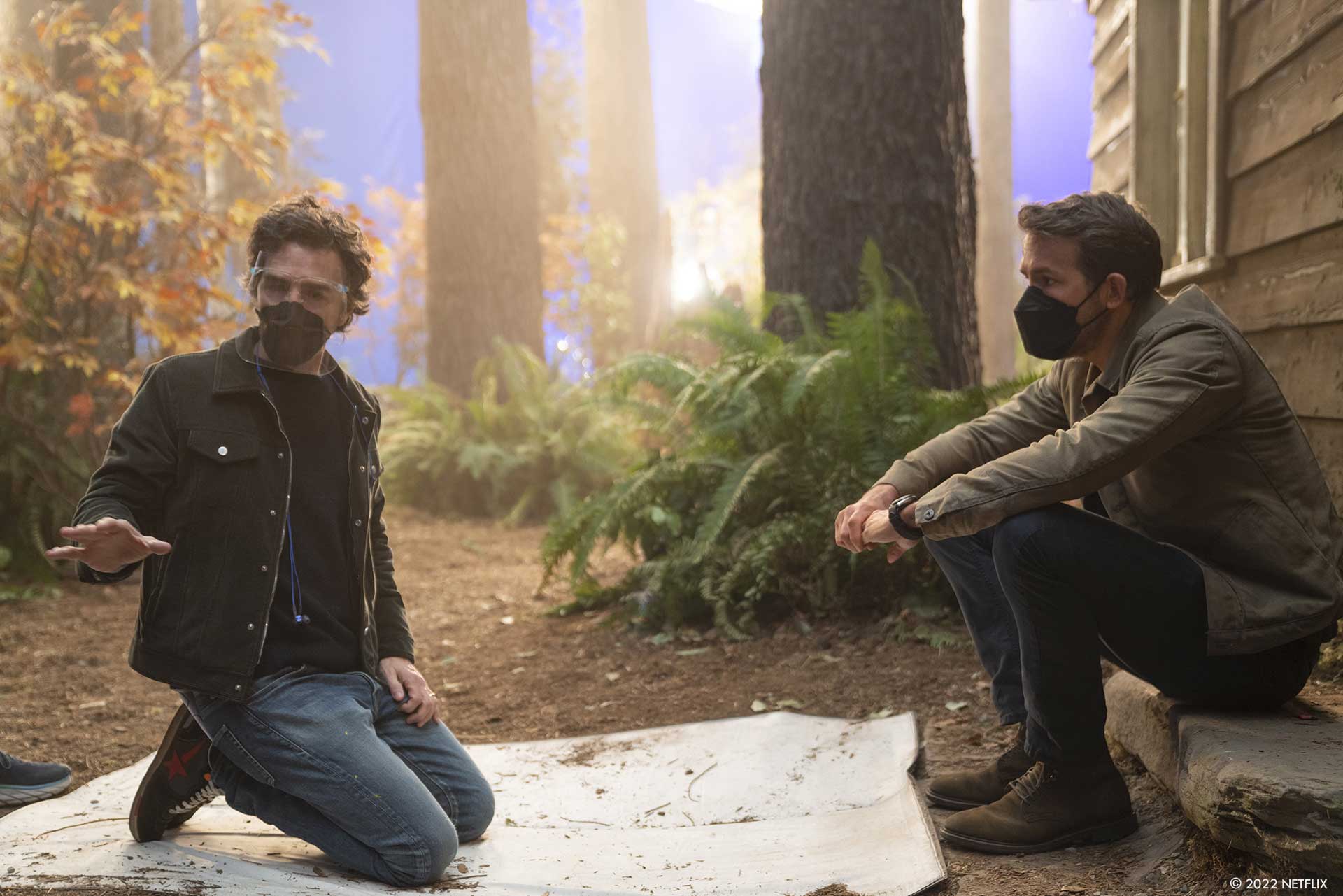
How did you organize the work with your VFX Producer?
I was lucky enough to work with the excellent Cari Thomas, who had already set up the show and organized our schedule. This helped me immensely and allowed me to focus mainly on the creative challenges. We would still make some adjustments to our schedule as a team because of some last-minute changes with our VFX Vendors, but overall, I felt very well supported by Cari and the rest of our production team.
How did you choose the various vendors?
When I joined the project, we already had Scanline VFX, Lola VFX, Supervixen, and an in-house team on board. But we still needed to find a home for some challenging sequences. Because of my past at DNEG and my good relationship with them, I felt they were the right fit to deliver the remaining work with a compressed schedule.
Can you tell us how you split the work amongst the vendors?
Scanline VFX was our lead vendor, led by Nick Crew. They handled most of the VFX in the backyard, including the set extension, helping design the weapons, the time soldier cloaking/decloaking effect, and their decimation. They took care of all the exterior Lab scenes, creating an impressive full CG environment (the scene was shot outside Canada Place in Vancouver, BC), and finally handled all the work inside the Lab, a fully CG environment.
DNEG London, led by Alexander Seaman, worked on all the Jets-related scenes, the car chase, and other self-contained beats. They also designed the Wormhole and the Jets decloaking effect.
Lola VFX, led by David Hernandez, oversaw Soryan’s de-aging and helped with complex face replacement shots.
Our fantastic In-House team, led by Suzette Barnett, worked on many shots throughout the film, too many to mention, including the backyard set extension using Scanline’s assets.
Led by Daniel Bavell and Morten Rowley, Supervixen was our unsung hero! Their design work can be seen throughout the whole movie, all the way to the main on end!
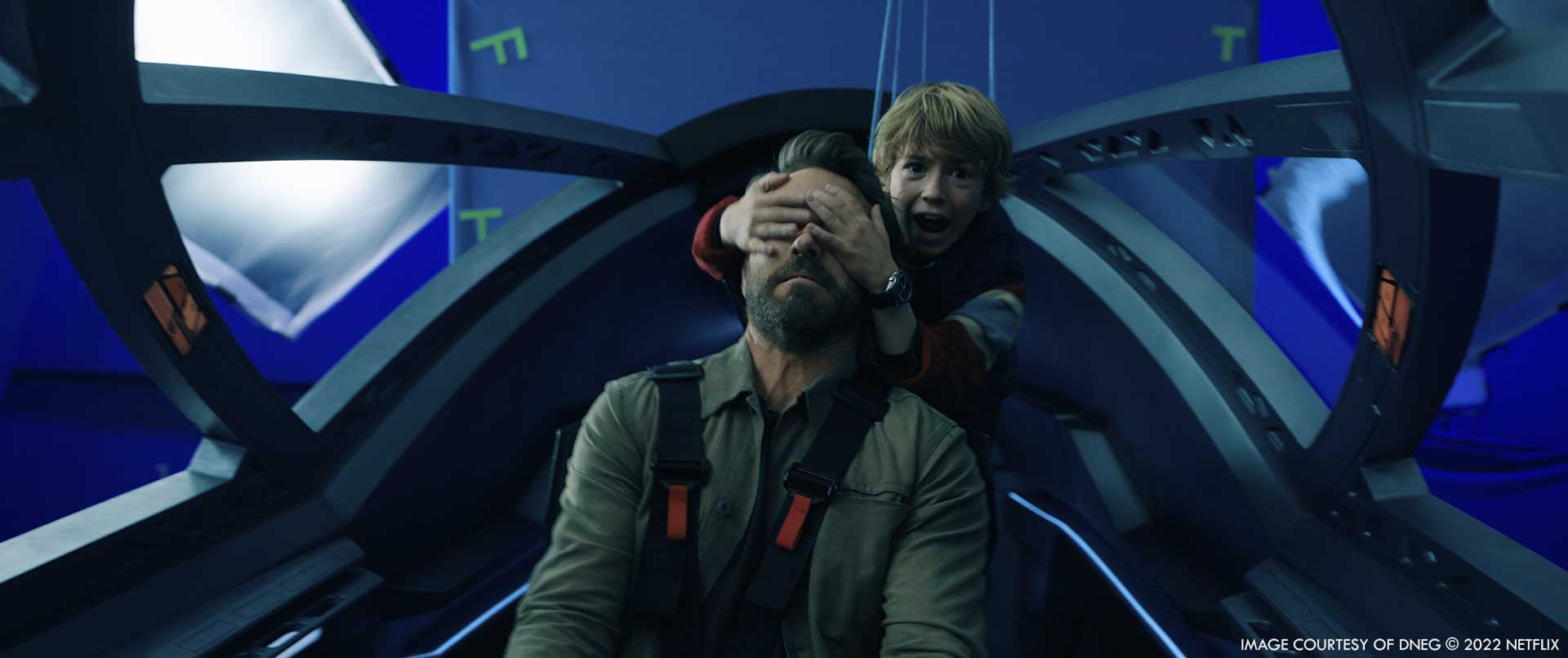
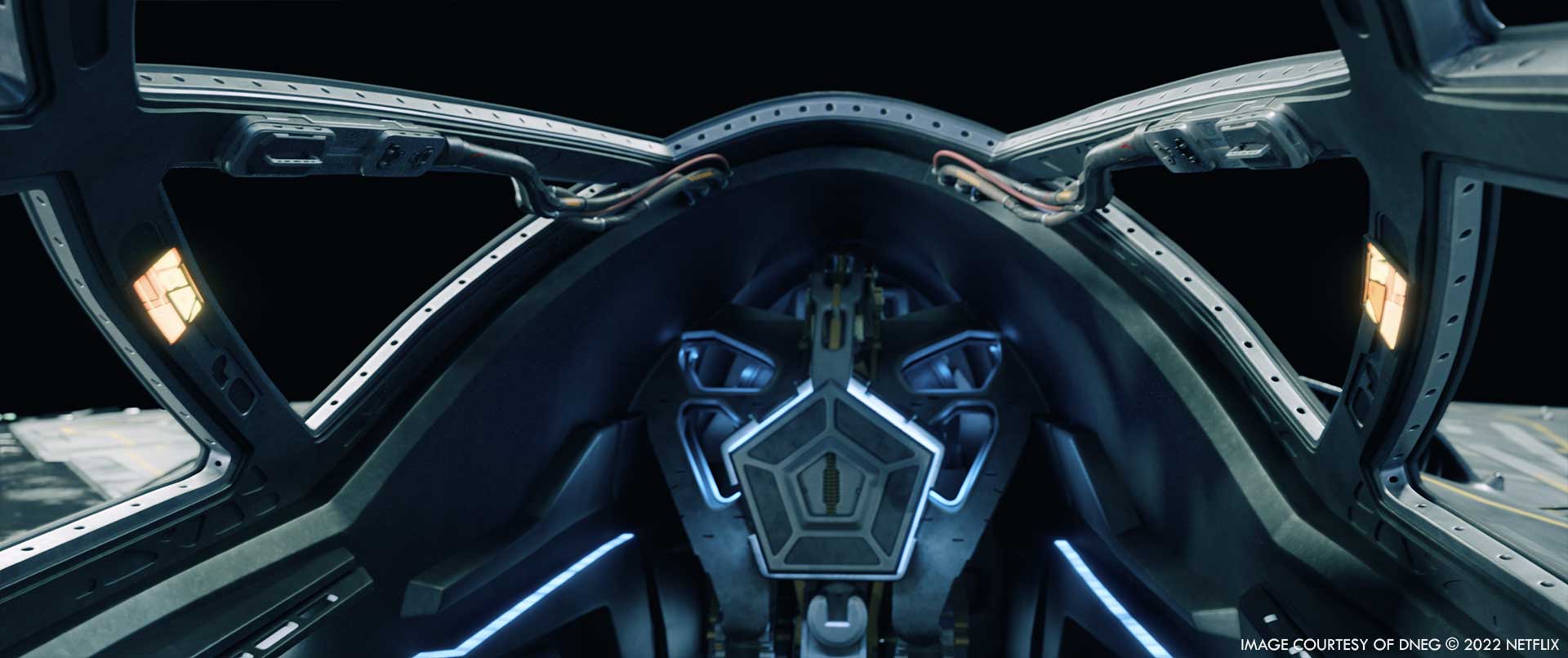
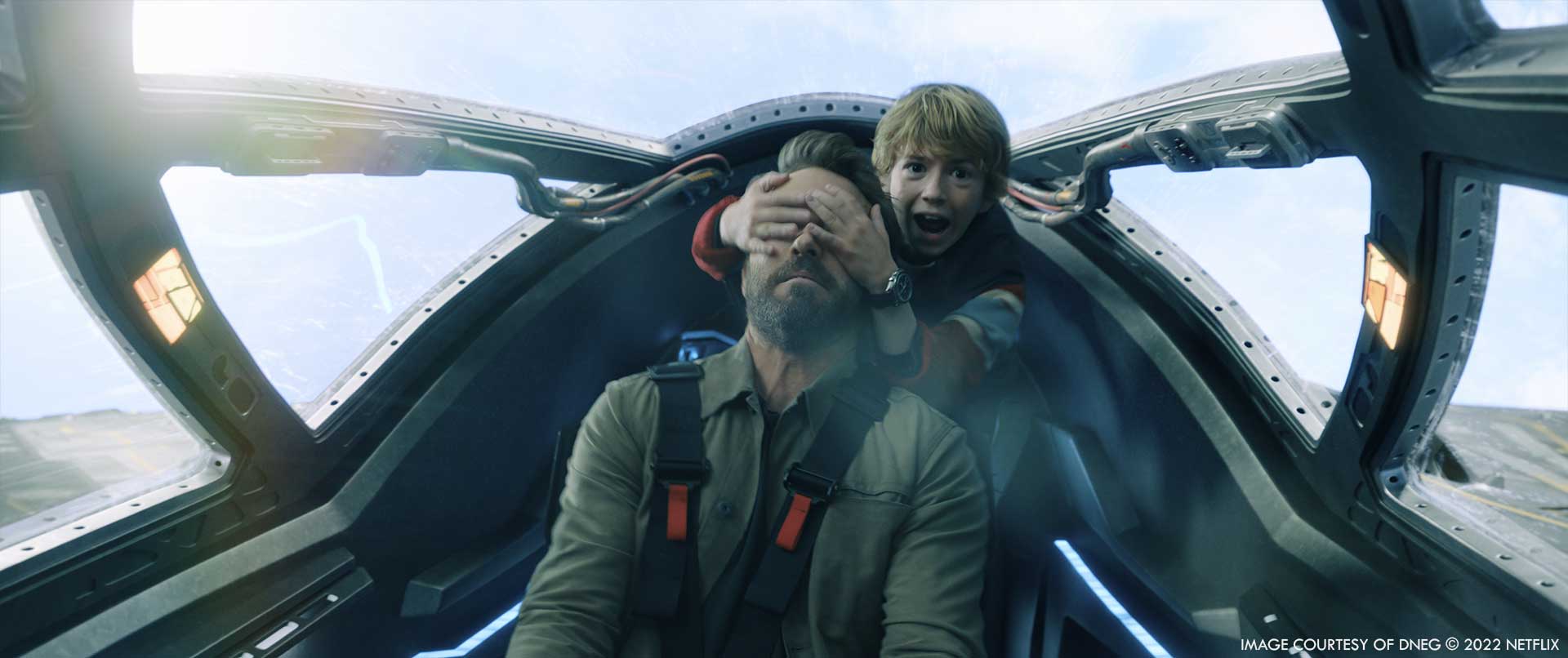
How was the collaboration with their VFX supervisors?
A collaboration! I always like the supervisors and their team to be as engaged as possible, own their work, and develop new ideas. I believe this is the best way to deliver good work, even more so with tight schedules. We had a lot of “magical” looks to design, which is always tricky because it’s very subjective. Shawn likes options, so I worked closely with the teams to make sure their work was in line with Shawn’s expectations and invited them to experiment with different concepts.
Can you elaborate on the design and creation of the spaceships?
When I joined the project, we already had approved designs for Soryan and Adam Jets. Soryan Jet was designed by our friends at Supervixen; I was happy with it, but I felt it needed some extra detailing to break up the mostly flat surfaces and panels, and DNEG took care of that. Adam’s jet design was done in Pre-production by the art department. The design was based on a traditional fighter jet but felt a bit simplistic. The lack of vertical stabilizer, air intakes, and visible weapons made it boring when seen from a frontal or lateral view. So, I asked DNEG to re-work the model, breaking up its silhouette but maintaining the original triangular shape. We also made sure to use the rear air brakes whenever possible during its animation. DNEG also came up with extra detailing work we did in the practical cockpit, replacing the practical mullions adding wires and trim panels here and there.
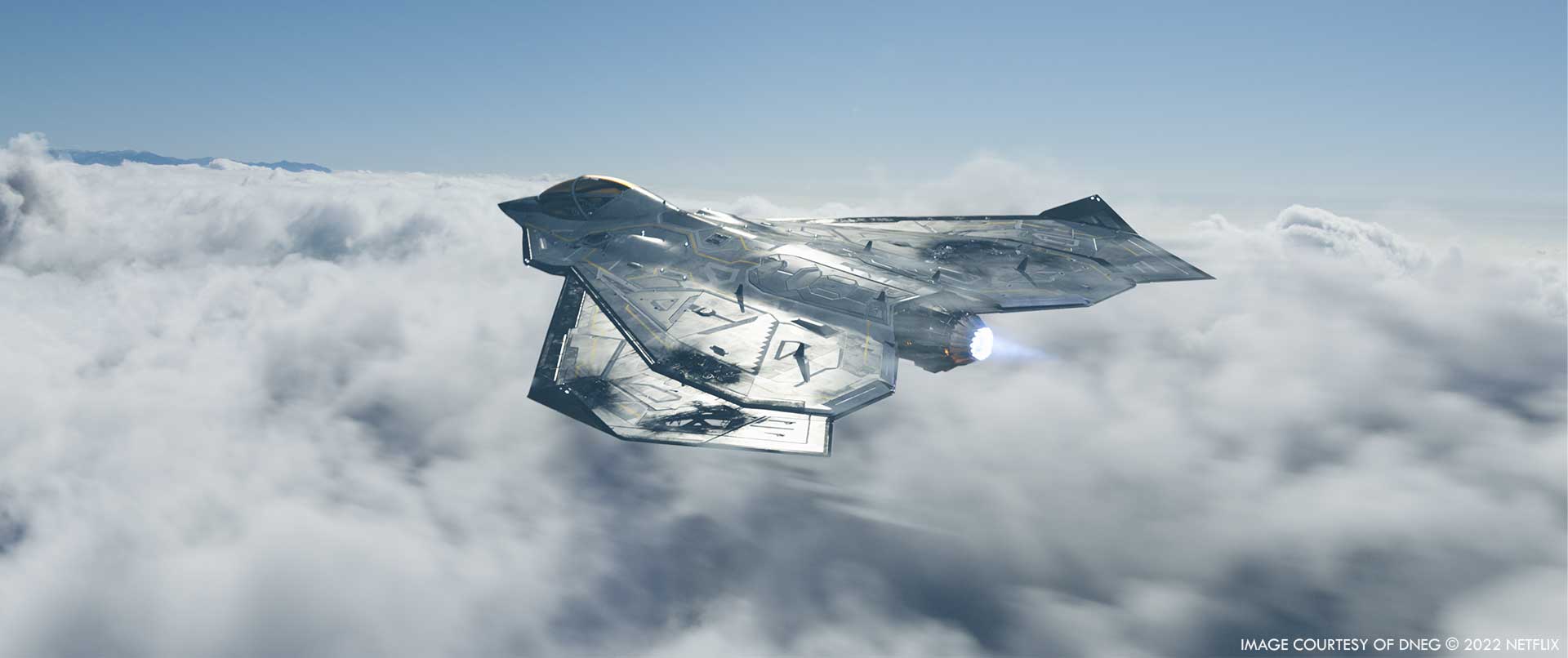
What was your approach for the dogfight sequences?
The dogfight mainly was prevized by Proof before my time, but when I joined the project, I wanted to amp up the overall energy, so I’ve asked Alex Cannon and his previz team at DNEG LA to work on a few new shots and redesign others. Because of these changes, many of the aerial plates shot during principal photography couldn’t be used, so DNEG had to build fully CG environments, like the Canyons.
How did you create the various environments, such as the forest and Soryan Lab?
We have a lot of CG Environments throughout the film besides the forest and Soryan Lab. The whole backyard around the house was shot on a blue screen stage, so Scanline had to extend it in CG, and we also completely replaced the practical grass with a combination of CG and DMP.
When our heroes leave the main street and go off-road during the car chase, DNEG had to add hero CG trees and vegetation around the car. As mentioned above, DNEG had to build the CG canyon we saw during the dogfight, which turned out great.
The exterior Soryan Lab scene shot next to Canada Place in Vancouver required a fully CG environment. The building was designed by Supervixen and handed off to Scanline, which also created the surrounding CG trees, the waterfront, the giant sculpture and replaced the BG with the Seattle skyline. I think we only kept the ground! And finally, the whole interior Lab was fully CG. Like the exterior, it was designed by Supervixen and handed off to Scanline.
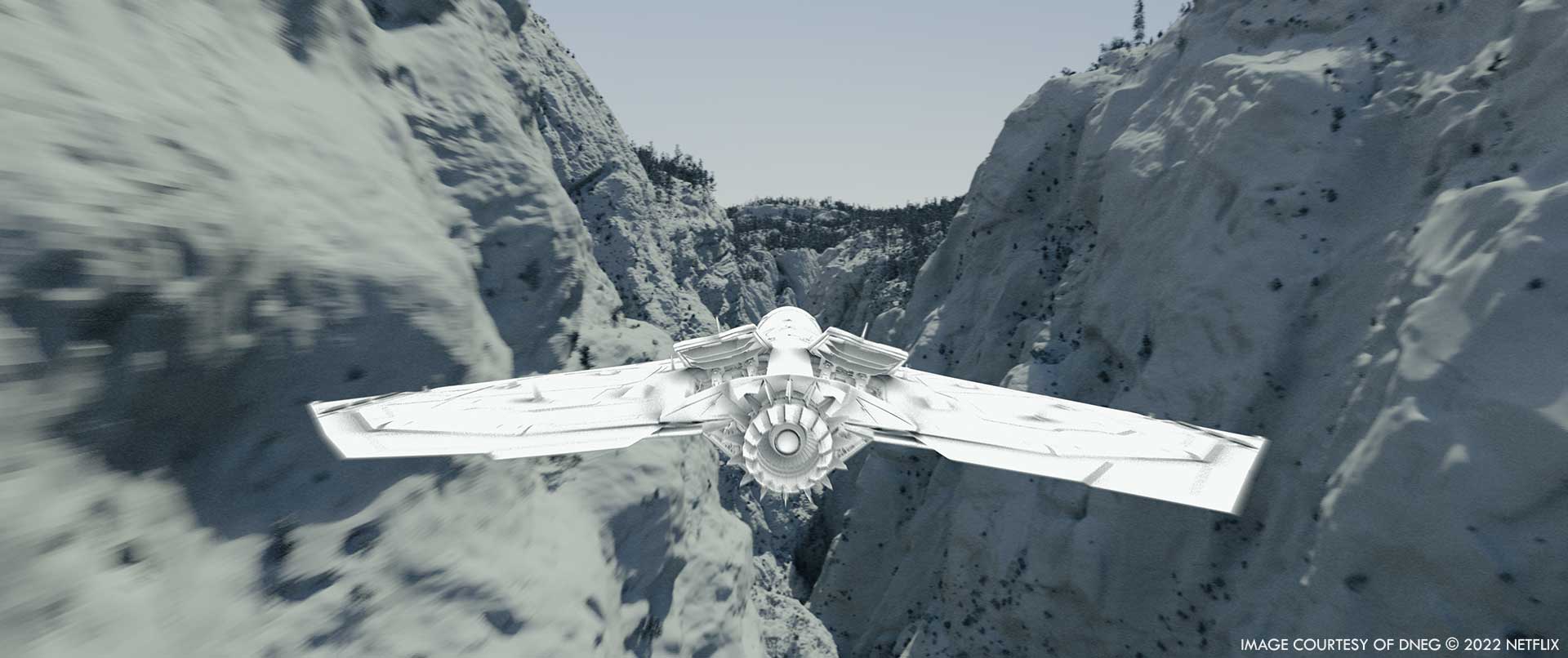
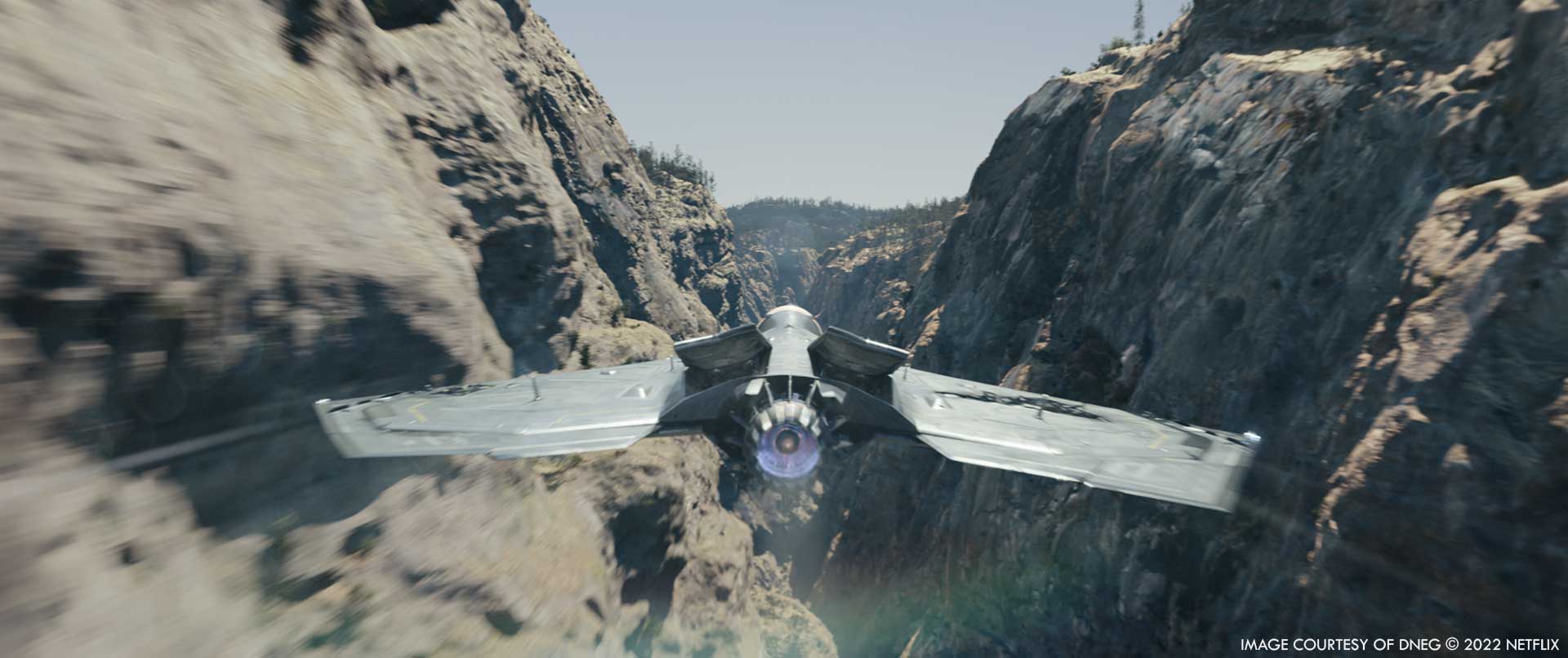
Where were filmed the various parts of the movie?
The film was shot in Vancouver, BC, mostly on stage, and we did a little PU on a stage in New York City.
Can you explain in detail the design and creation of the wormhole?
We wanted to design something that was somehow based on the traditional pseudo-science for the Wormhole but also felt a bit different. So, with DNEG, we came up with what looks like a light-bending flat disk from the outside with the familiar swirling funnel look on the inside.
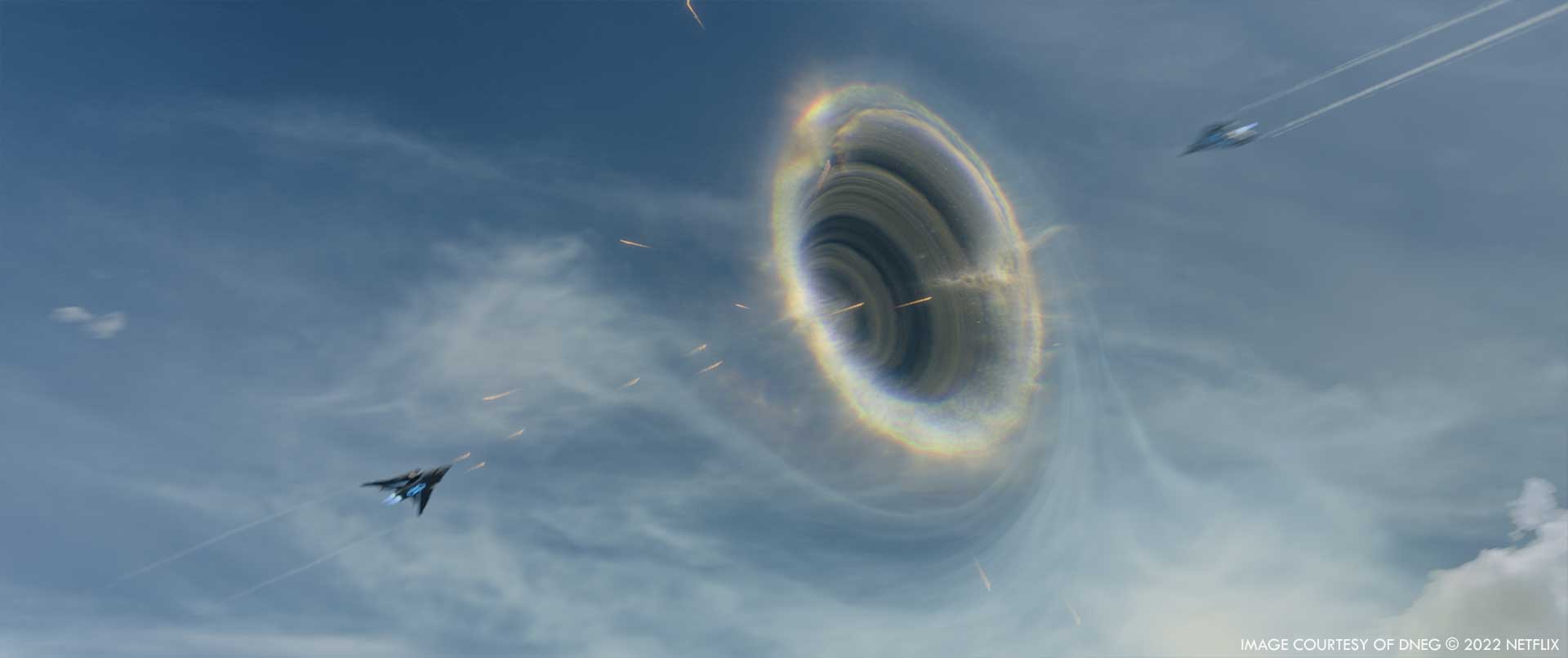
What kind of references did you receive for the wormholes?
We didn’t have many references; I asked DNEG to develop some preliminary concepts, although most of the look was created in 3D.
Let’s talk about other FX work. How did you design the camouflage and disintegration effects?
Scanline VFX did the Cloaking and Decloaking effects of the Time Soldiers. We did many tests, mostly on how to affect the environment without solely relying on the typical “Predator” look while ensuring the effect didn’t read as teleportation. The effect is based on a simulation that gives the impression of tearing the space surrounding the Soldier with some spike-like shapes. This design then was used as inspiration for the Jet’s decloaking, done by DNEG.
The decimation effect was a fun one to develop. The script pages described it as an event like drops of paint splatting on a canvas that was exploding/imploding. The idea was to avoid anything that looked too violent, not imply an actual death, and, most importantly, make it look cool. At some point, Ryan Reynold came up with the idea of a feeling like a burst of skittles [the candies]. So, with those ideas in mind, I worked with Nick and his team at Scanline to create something impactful with a cool and colorful factor. Scanline came up with many exciting ideas, and ultimately, we picked the best elements from a few different ones. Because when the Soldiers decimates their movements turn into slow-mo, Scanline also had to turn them into digi-double since the actual performance was shot at 24 frames.
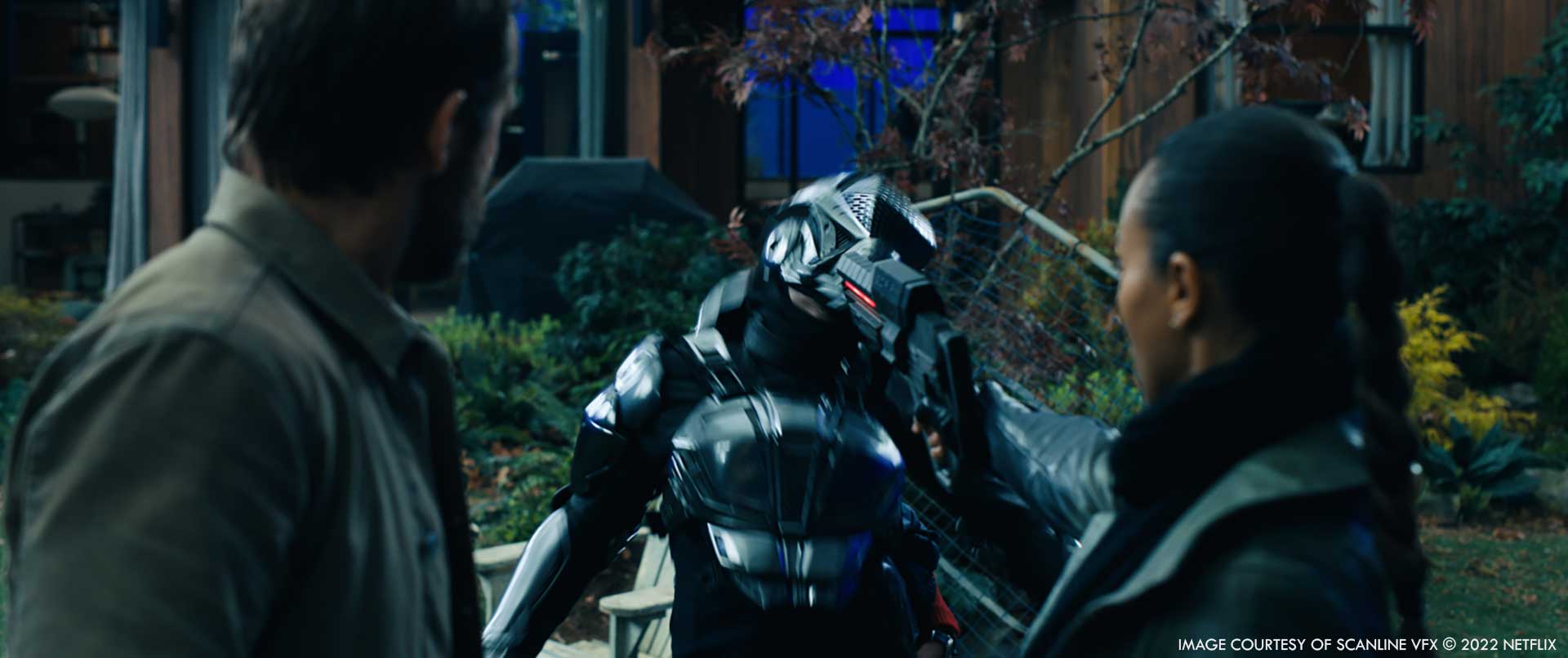
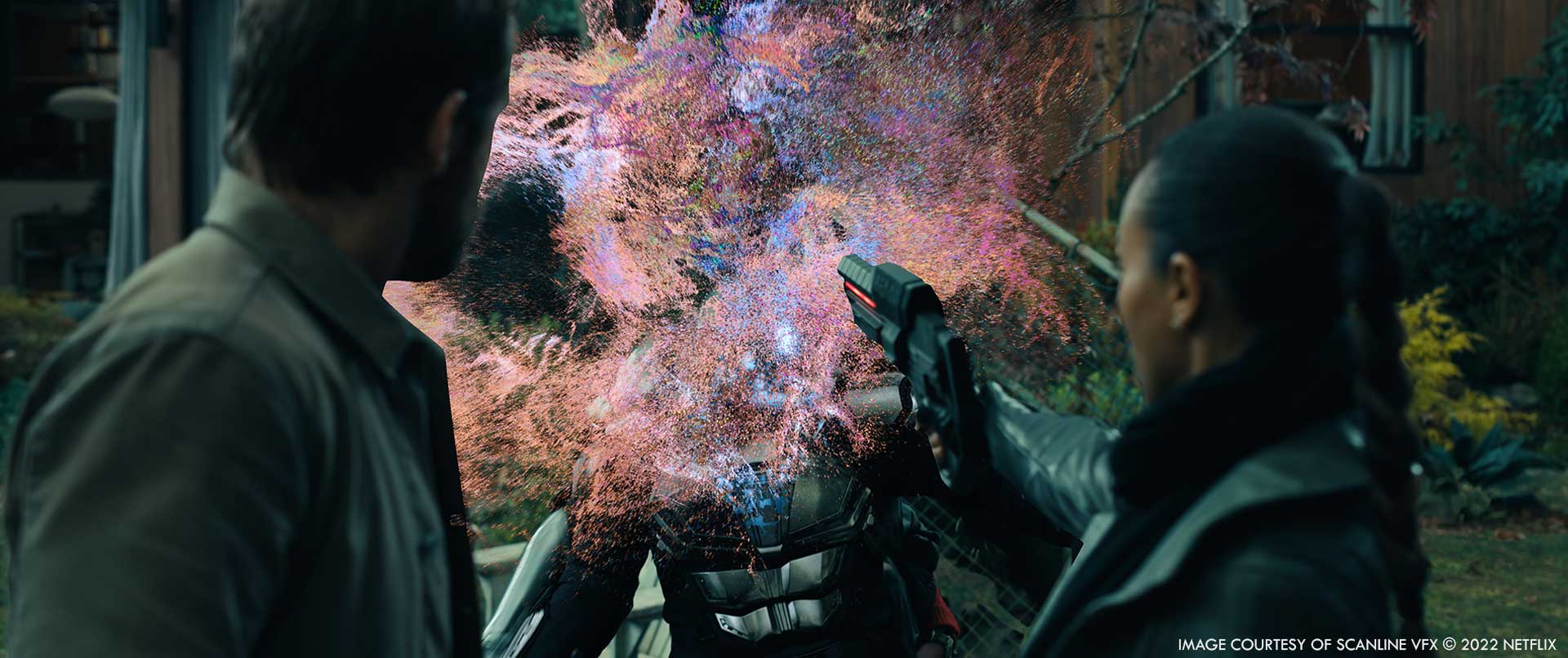
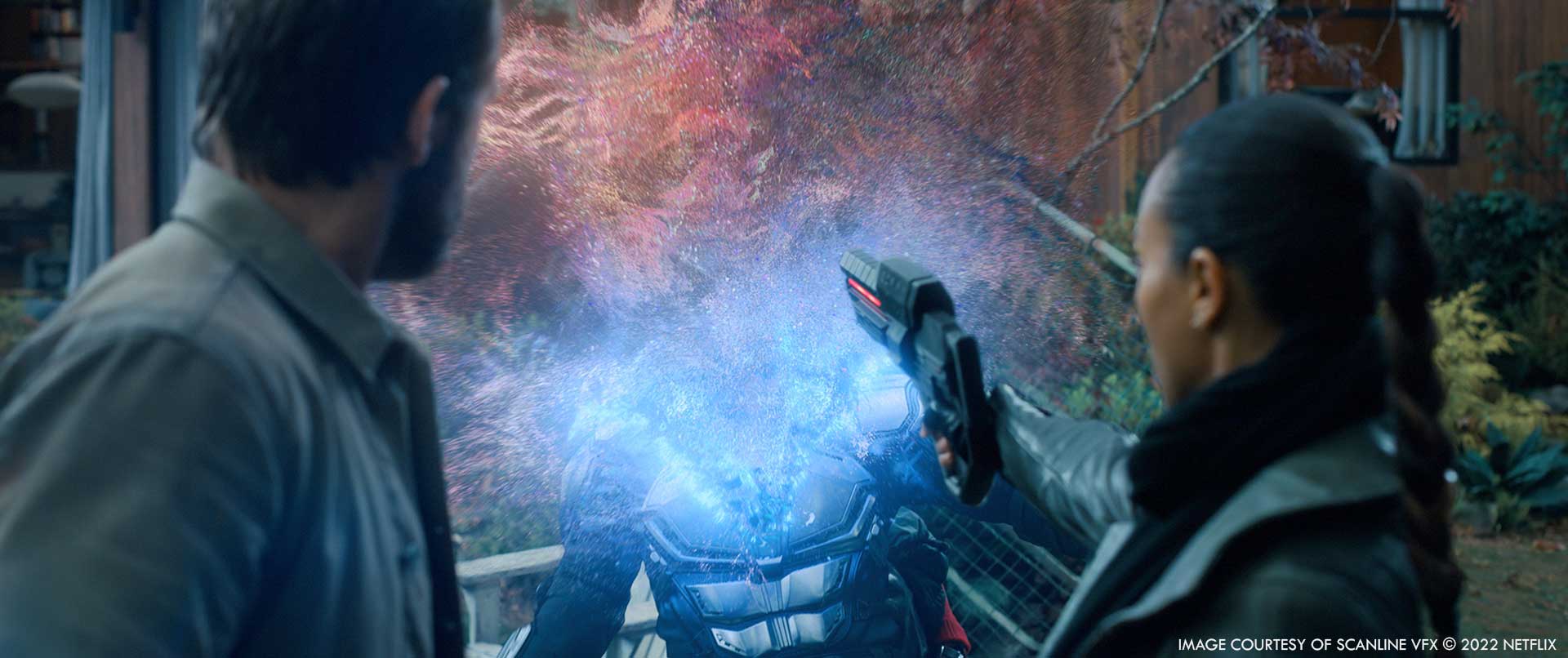
Can you tell us more about the various weapons?
Big Adam brings from the future a couple of cool gadgets to help him in his mission to save the world; one of these is the MagCyl, which, as Young Adam points out in a couple of scenes, looks like a Light Saber, but it’s not a Light Saber. The Art Dept did some early concepts, but none of them felt suitable for what Shawn was after. We gave the concepts to Scanline and came up with new ideas. It was a bit tricky because it had to expand and collapse with some sort of mechanical elements and at the same time had to have a form of energy powerful enough to not only decimate the Time Soldier but also deflect bullets (like in the scene outside the lab), propel our hero and create destructive energy blasts.
Scanline did a great job coming up with the final design and animation; Shawn added a couple of extra shots to give it proper screen time!
Another weapon we briefly see at the beginning of the Back Yard Fight is the Pulse Grenade; once again, Scanline created the effect, which we then used as inspiration for the MagCyl when it blasts energy and later for the Drone in the Exterior Lab fight.
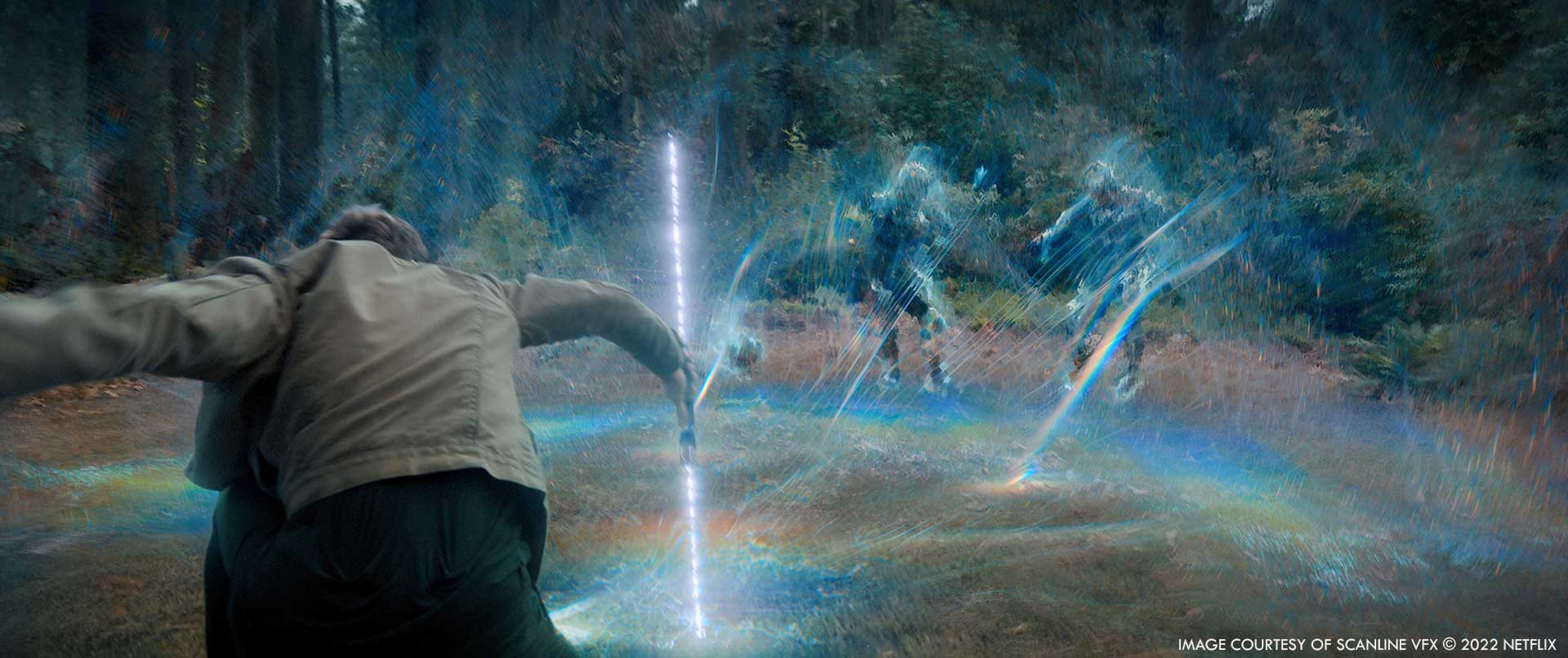
Can you elaborate on the rejuvenation work?
Lola VFX took care of de-aging Catherine Keener using their now-famous specialized rig called “The Egg.” Essentially, we shot all the scenes with Catherine and her body double; we then captured Catherine inside The Egg at Lola VFX here in Los Angeles, where she re-delivered Young Soryan dialogue lines. Once we picked our selections, Lola projected Catherine’s head over her body double. Our editors then would cut these passes in the Avid to ensure the performance worked correctly in the scene context. Once approved, David Hernandez and his team at Lola would then work on the de-aging in Flame. To re-create the set lighting, the team at Lola VFX manually programmed LED light that surrounds the actor, which is done on a pre-light day using a stand-in. To hit eye lines, head turn, etc., the rig also uses colored LED lights used as markers/cues the actor can follow without relying on a video feed.
The final sequence involved massive destructions. Can you tell us more about this aspect?
This was indeed massive! The scenes inside the lab were shot on a blue screen stage with a minimal practical build. In essence, everything you see surrounding the actors was fully CG. We only had the platforms/stairs they walk on, a few props, and a partial build of the two circular particle accelerators, although they were also completely replaced. This scene was tricky because of the complex simulations required and because the Lab’s design changed once in post, and so did the overall lighting, which means dealing with interactive lighting on our talents. Scanline built the new lab from a design done by our friends at Supervixen and then destroyed it!
We had a little bit of everything, full CG shots with dig-doubles, water sim, complex face replacements, Young Sorian de-aging, extensive effect simulations, and the final collapse of the entire lab. We divided the scene into three parts to better track shot progression and hit vital story points. The first part is when everything is quiet, from when Louis and Adam enter the Lab until when Soryan shoots the gun and hits the containment glass. That’s when part 2 starts and where things start to go nuts because of the faulty magnetic field. We have flying objects, flying time soldiers (their suits are made of metal), camera shake, sparks, electric bolts, etc.
Then after Christos’s defeat, we enter part 3, which culminates with the total collapse of the Lab.
Scanline did a great job handling the complexity of the scenes and its 300+ shots.
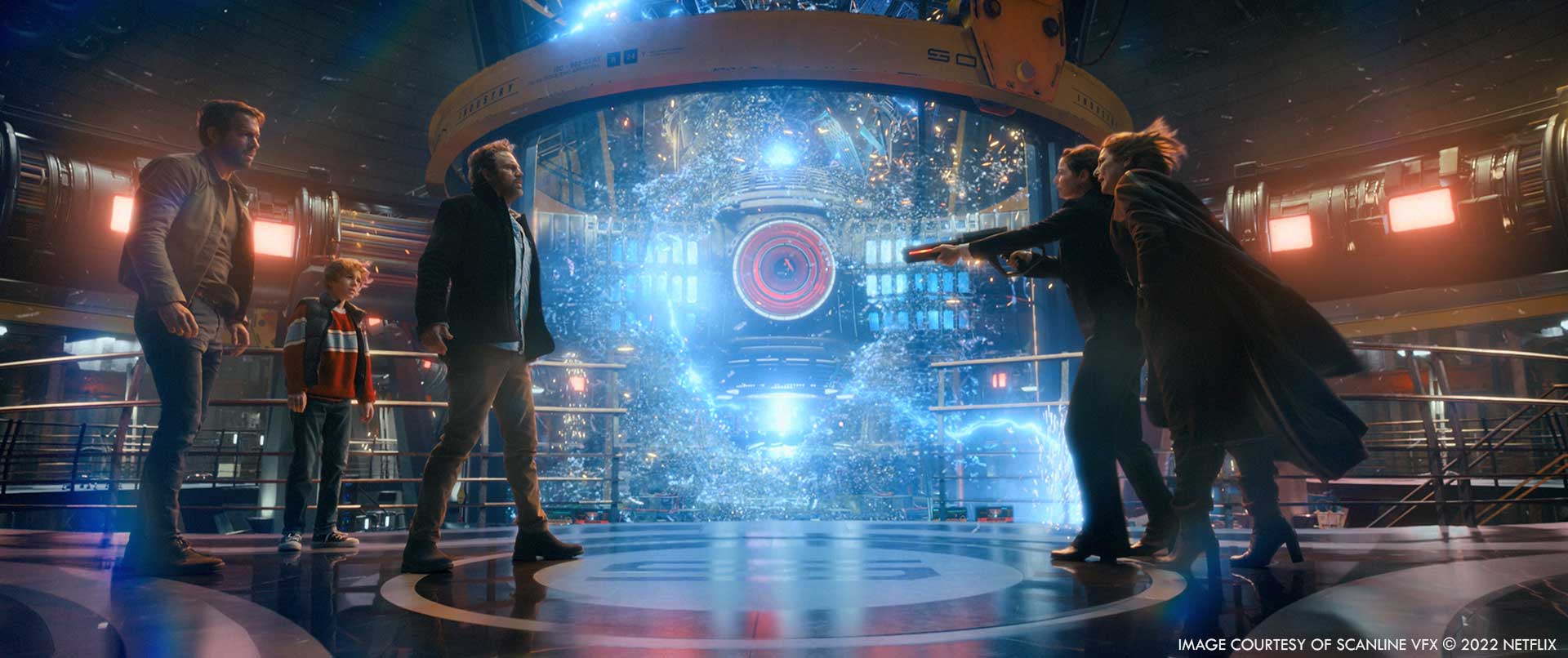
Did you want to reveal to us any other invisible effects?
There are so many scattered throughout the film!
Which sequence or shot was the most challenging?
They all had their challenges, but a fantastic team of artists supported me.
Is there something specific that gives you some really short nights?
I love my 8 hours of sleep, but certainly, the project was challenging because of the schedule.
What is your favorite shot or sequence?
I don’t like to choose my favorite child!
What is your best memory of this show?
I have many, but the best times were seeing Shawn jumping in excitement while reviewing shots!
How long have you worked on this show?
About six and half months.
What’s the VFX shots count?
1432.
What is your next project?
I can’t say just yet… but it’s a fun one!
A big thanks for your time.
// Behind the FX of The Adam Project | Netflix
// Behind the Scenes of The Adam Project | Netflix
WANT TO KNOW MORE?
DNEG: Dedicated page about The Adam Project on DNEG website.
Netflix: You can watch The Adam Project on Netflix.
© Vincent Frei – The Art of VFX – 2022



